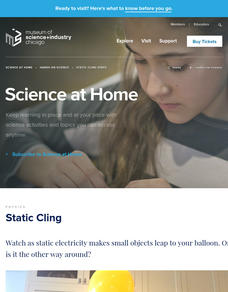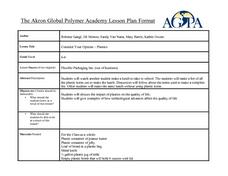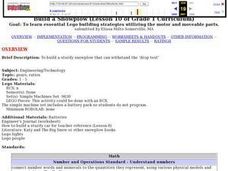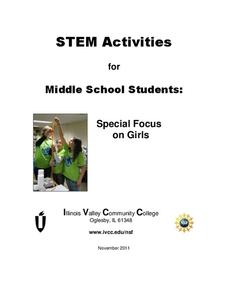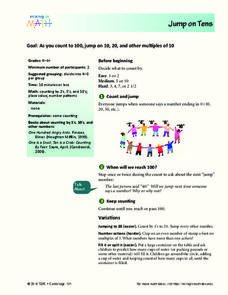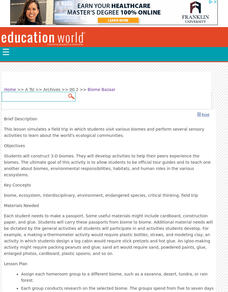Curated OER
Now You Have It, Now You Don't
Sixth graders compare corn-based shipping peanuts to Styrofoam shipping peanuts. In this hands-on environmental awareness lesson, 6th graders try dissolving two different types of packing peanuts in water.
Curated OER
Now you see it....Now you Don't
Students investigate the biodegrading process of packing peanuts. In this biological process activity, students conduct an experiment to see how quickly packing peanuts biodegrade. Students check the process each day and record their...
Museum of Science
Static Cling
Cling to a lesson on static electricity. Pupils take part in experiments where they see how paper from hole punchers, packing peanuts, puffed rice cereal, and other items react when placed near a rubbed balloon. They learn how electrons...
Curated OER
Styroflakes
Students increase eye-hand coordination as they create decorative snowflakes out of recycled packing peanuts.
Curated OER
Now You Have It, Now You Don't
Students compare shipping peanuts made from corn and made from Styrofoam. In this corn based peanuts lesson plan, students understand why to use eco-friendly materials for packing. Students participate in an experiment to compare the...
Curated OER
Benne Cakes and Other Holiday Recipes
Benne Cakes, a West African treat packed with sesame seeds for luck, are a featured part of the celebration of Kwanzaa. Young chefs try their hand at crafting these goodies that are sure to enrich your holiday...
Curated OER
Air Takes Space
Students discover that air takes up space by watching the teacher demonstrate a simple activity using a glass jar, styrofoam packing peanut, and a clear bowl of water.
Curated OER
Bioplastics
Students define bioplastics and identify its uses. In this bioplastics lesson plan, students compare and contrast styrofoam to starch peanuts after careful examination. Students understand what biodegradeable means.
Nemours KidsHealth
Food Allergies: Grades K-2
Students explore different types of food allergies. In this food allergy lesson, students look at what foods people with peanut, seafood, milk, egg, soy or wheat allergies have to avoid. They create a button for a student with an allergy...
Curated OER
Consider Your Options-Plastics
Students explore plastics and what plastics students use to pack a lunch. In this plastics lesson plan, students observe each other pack lunches and take note of all the plastics used in packing the lunch. They discuss the impact of...
Curated OER
The Magic Of Static Science Station Experiment
In this magic of static electricity set of station activities worksheets, learners perform 4 activities with static electricity including popping corn, jumping peanuts, weird water, and dancing balloons. They complete the recording...
Curated OER
Build a Snowplow
Students design and build a snowplow using LEGO materials. They compete in an Engineer's Challenge to clear a path through Styrofoam peanuts.
Chymist
Landfills and Recycling
Examine the nature of landfills through experimentation. Scholars build miniature landfills and monitor changes over a six-week period. Observations allow individuals to draw conclusions about the different types of trash and their...
Curated OER
#24 How Much Air Is In Foamed Polystyrene Products?
Students are challenged to come up with a good estimate of the amount of air in foamed polystyrene products. They use this gas evolution experiment and as such have students measure the gas generated when foamed polystyrene is degassed...
Curated OER
Too Heavy For Me
Students explore the different arrangement of air molecules in high and low air pressure masses. They compare the temperature of high and low pressure masses and discover how a barometer works.
Illinois Valley Community College
STEM Activities for Middle School Students
Use STEM activities within the class to provide connections to concepts. The resource includes activities that range from working with buoyancy to building rockets and launching them. Other activities involve the engineering design...
Curated OER
Jump on Tens
Give the actors in your class a chance to shine as they act out skip-counting. In their roles, they take turns shouting out different number patterns and jumping when reaching the given goals set for each number family. A fun and...
Curated OER
Crazy Chemistry Lesson Plan
Students study water molecules, cohesion and surface tension. In this molecule cohesion lesson students create chemical reactions that cause a balloon to inflate and another one that results in soap suds.
American Psychological Association
A Tasty Sample(r): Teaching about Sampling Using M&M’s
Here's a sweet activity! As part of a study of psychological research methods and statistic gathering, individuals develop a hypothesis about the number of each color of M&Ms in a fun-size package. They then count the number of each...
Curated OER
Biome Bazaar
Middle schoolers construct 3-D biomes. The ultimate goal of this activity is to allow students to be official tour guides and to teach one another about biomes, environmental responsibilities, habitats, and human roles in the various...
Curated OER
A POSITIVELY NEGATIVE EXPERIENCE
Students work in cooperative learning groups to discover how Gauss's law applies to conductors and dielectric materials. They use an electroscope to detect electrostatic charge and determine location of charges during static charge.
Curated OER
Water Filtration Competition
Students design water filtration systems. They draw sketches and write paragraphs about their systems. After presenting their systems to the class, each group then builds their system and determines its effectiveness for purifying...
Curated OER
Design a Plankton
Learners explore animal and plant adaptation. In this ecosystems science lesson, students view websites to gain information about plankton and its interdependence within ecosystems. Learners identify ways in which plankton...
Curated OER
Watering Can
Pupils problem-solve a technique to pass pass a one gallon water container around a circle without using any hands or arms and making sure that everyone in the circle has touched the container. After several attempts, they reflect of the...




